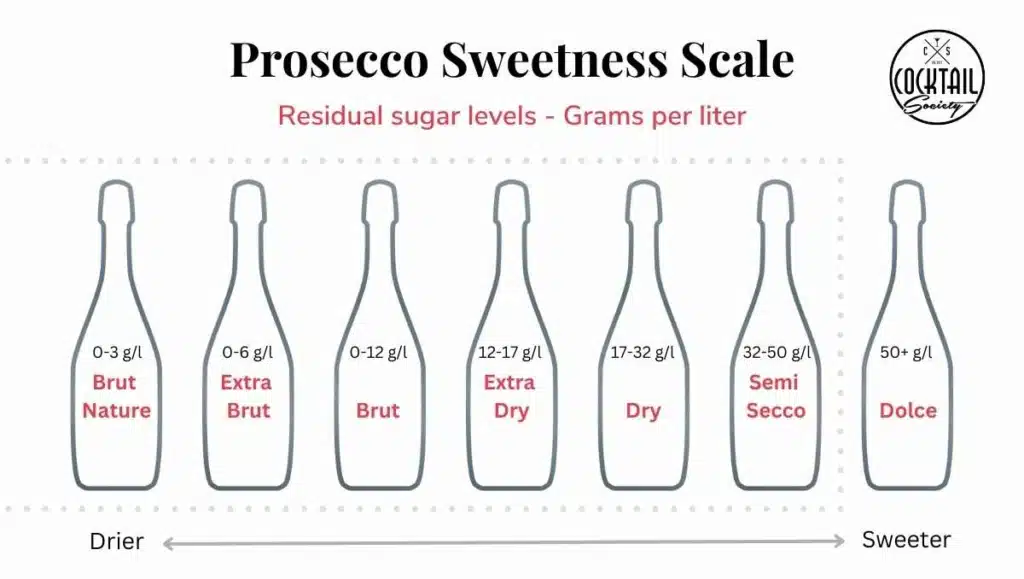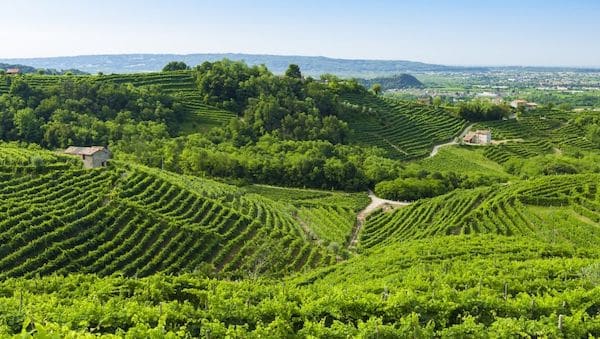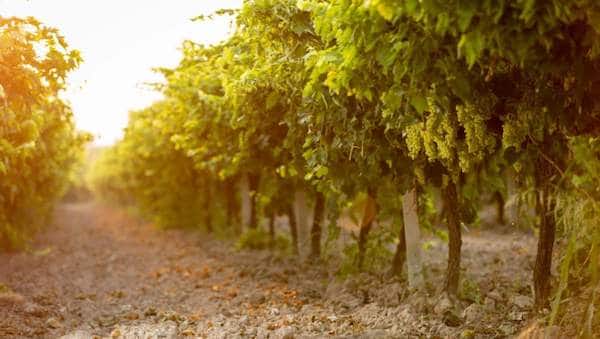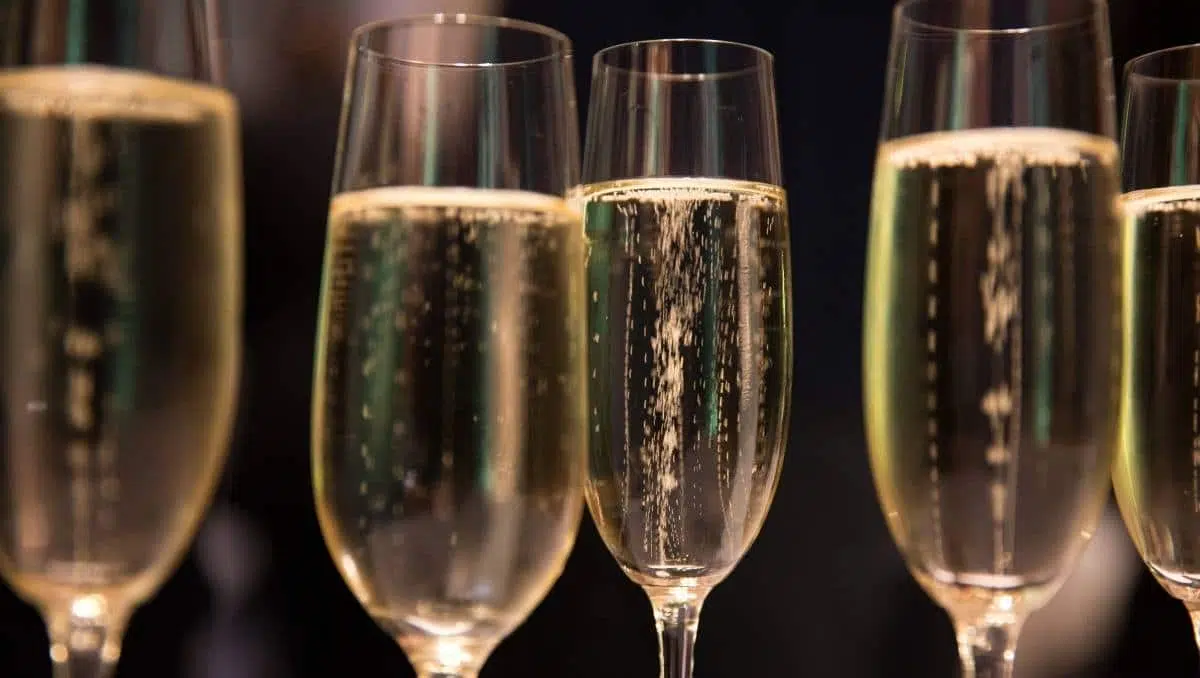Prosecco is a specific type of sparkling wine from the Valdobbiadene region of Veneto in the Northeast of Italy. It comes in three different types: Tranquillo, Frizzante, and Spumante.
Each of these types can be categorized into one of the following six sweetness levels: Brut Nature, Extra Brut, Brut, Extra Dry, Dry, Semi-Secco (or Demi-Sec), or Dolce.
Finally, these different Prosecco are divided into three quality levels. That means that each bottle must be labeled with a DOC or DOCG seal. Depending on the seal, the product must meet certain grape quality criteria like growing in certain regions, at minimum altitudes, and at certain soil conditions.
So, here is our guide for everything you need to know about the different types of Prosecco, their characteristics, quality levels, and legal regulations.
The three types of Prosecco
There are generally three different types of Prosecco: Tranquillo, Frizzante, and Spumante. These describe the three different levels of Effervescence.
Spumante is sparkling, Frizzante is semi-sparkling, and Tranquillo is non-sparkling. The more fizz, the higher the pressure inside the bottle. Therefore, Spumante bottles have at least 3.5 bars, whereas Frizzante cannot have more than 2.5 bars. Here's what you need to know about these Prosecco types.
Tranquillo
Tranquillo, as the name suggests, is a flat Prosecco. So no bubbles at all. It has a deeper color compared to the sparkling versions. It is far less common than the other two types of Prosecco and hard to get outside Italy.
Frizzante
In Prosecco Frizzante, the carbonic acid content is lower than in Spumante. This smaller amount of carbonic acid dissipates very quickly after opening the bottle.
That means that your Prosecco Frizzante quickly becomes stale. It's, therefore, less expensive than Spumante. Compared to the fruitier notes of Spumante, Frizzante is somewhat more citrusy and a little sweeter.
Spumante
By far the most common and fizzy style of Prosecco is Spumante. It has a fruity taste, a fine perlage (basically the behavior of the bubbles) that is long-lasting and can be any sweetness level from dry to semi-dry. Also, its production follows stricter standards than Frizzante or Tranquillo.
The Prosecco Sweetness Scale
Prosecco, like all sparkling wines, comes in different sweetness levels, and it is available in all six of these levels. -The driest one also being the latest addition to this list. The classification below applies to all types of sparkling wines, including Champagne.

- Brut Nature, also known as Brut Zero or Ultra Brut, contains 0 - 3 g/l of residual sugar and is absolutely bone dry to the taste.
- Extra Brut has up to 6g/l of residual sugar and still tastes very dry.
- Brut can contain anything from 0 to 12 g/l of residual sugar and might still be a little too acidic for people not used to the taste.
- Extra Dry sounds as if it should be the driest of them all, but it carries 12 -17 g/l of residual sugar, and you can taste a hint of sweetness.
- Dry, also known as Sec or Secco, actually is medium dry and contains 17 - 32 g/l of residual sugar.
- Semi-Secco or Demi-Sec already has up to 50 g/l residual sugar and is quite sweet to the taste. That is also as sweet as Prosecco gets.
- Dolce is a sweeter category on the list, in which non of the types of Prosecco is available. But for the sake of having things complete: Dolce is the sweetest type of wine and includes everything above 50g sugar per liter.
The sweetness scale is a little confusing, I know. For one, why is Extra Dry, not the driest but somewhere in the middle instead? The answer is quite simple: In the early days of sparkling wine, the classification started with Dry.
But then producers brought even drier bubbly on the market and called it Extra Dry, and that went on until now we have Brut Nature as the ultimate dry version.
Different quality levels of Prosecco
In addition to the classifications of fizz and sweetness, Prosecco can also be categorized into different quality levels. But that wasn't always the case.
Since 2009 there are quality standards for Prosecco. And they ensured that the sparkling wine regained its initial prestige. Now each bottle must be labeled with the seal DOC or DOCG. DOC stands for Denominazione di Origine controllata and identifies Prosecchi that come from one of the official Prosecco growing areas in Friuli Venezia Giulia. [1]
DOCG is short for Denominazione di Origine Controllata e Garantita and denotes the highest quality level for Prosecco wines. This label is reserved for products from the regions of Asolo, Valdobbiadene, and Conegliano.
Prosecco DOC
The Prosecco DOC production area is characterized by climate conditions ideal for the Glera grape: a mild temperate, sufficient average rainfall, and alluvial soil with enough minerals. You can further distinguish Prosecco DOC into:
- DOC Veneto: the vineyards and production are exclusively in the Veneto region
- DOC Marca Trevigiana: the vineyards and production are exclusively in the Treviso province
- DOC Colli Trevigiani: harvesting and production are exclusively at the foot of Treviso vineyards
Prosecco Superiore DOCG of Conegliano Valdobbiadene
For this quality grade of Prosecco, producers use only grapes that grow at an altitude between 50 and 500 meters above sea level on the south-facing slopes of the vineyards. In return, they can add the term Conegliano Valdobbiadene onto the label of their bottles. Prosecco from these areas carrying that quality seal also always is Spumante.
Prosecco DOCG of Valdobbiadene Prosecco of Cartizze
The production area of Cartizze comprises 107 hectares of vineyards in the steep hills of Santo Stefano, Saccol, and San Pietro di Barbozza. All are located in the Valdobbiadene district. This territory meets crucial preconditions for Prosecco of the highest standards:
- The climate is relatively mild because the hills protect the wine from cold winds. And the exposure to the south guarantees maximum and steady sunlight that causes all grapes to ripen equally.
- Sediments of sandstones and clay are in the soil in this area. They allow rapid drainage of rain and a constant water supply. Just think of the plant pots with integrated watering systems. They follow the same principle.
Prosecco vs. Champagne
People often compare Prosecco to Champagne (pronounced shampanye), because just like the French sparkling wine, Prosecco is highly legally regulated. The main difference between the two is that Champagne must be produced within the Champagne region in France, whereas Prosecco is made in the Veneto region in Northern Italy.
In addition, unlike Champagne, Prosecco is usually produced by tank fermentation rather than bottle fermentation. This requires less manual labor, as the bottles do not have to be turned by hand. In return, Prosecco is a lot more affordable than Champagne and, therefore, more accessible for most of us.
The yields per yields-per-hectare of Glera in Italy are higher than in Champagne. That's partly due to environmental conditions and partly caused by the strict regulations for Champagne. These always ensure that the supply stays in line with the demand.
Also, the traditional champagne method - the Champenoise - emphasizes richness and complexity in sparkling wine. In contrast, the tank method used for Prosseco enhances fruitier aromas.
That makes Prosecco fresh and easier to drink. Champagne is full-bodied, more complex, and has an intenser perlage. That also reflects in the pressure. A bottle of fizzy Prosecco Spumante has 3.5- 4.5 bars, whereas a bottle of Champagne has between 5.5 and 6 bars.
What is Prosecco exactly?
Prosecco is a specific type of sparkling wine from the Valdobbiadene region of Veneto in the Northeast of Italy. It is a so-called DOC(G) white wine - with DOC (G) standing for Denominazione di origine controllata (e garantita).
Translated into English, this means it is a product with a controlled (and guaranteed) designation of origin. And actually, there are various types of Prosecco, as it comes in different styles, sweetness levels, quality grades, and different degrees of carbonation. In fact, Prosecco is available with no carbonation at all.
This affordable sparkling wine has become one of the most popular aperitifs in Western countries. It replaced regular bubblies on the menus of restaurants without us even consciously realizing that it did. But once you do realize, the questions of the difference between Prosecco and sparkling wine inevitably will pop up in your mind.
Legal Requirements
For a sparkling wine to be labeled Prosecco, it must fulfill a whole list of legal requirements. Here's a short overview of the requirements Prosecco must fulfill:
- Produced in one of nine Prosecco regions
- Min. alcohol content of 9%
- The main grape variety must be Glera (min. 85%)
- Produced with the Charmat method
- Only sold in glass bottles
First and foremost, it can only be produced in nine provinces of the Veneto and Friuli Venezia Giulia regions in Northeast Italy. These provinces are Belluno, Gorizia, Padua, Pordenone, Treviso, Trieste, Udine, Venice, and Vicenza.
The designated area for Prosecco is about 25ha in total. That's 8ha less than that for Champagne. Yet, the outcome of Prosecco is significantly higher than that of Champagne. 750 vs. 230 bottles in 2020.
Further, Prosecco must have an alcohol content of at least 9% ABV and be made from the Prosecco grape, renamed Glera in 2009 within the European Union. However, regulations allow up to 15% of the grapes to be of other varieties.
There are also directions regarding the plating patterns, minimum plantation density, pruning systems, and other external factors, that possibly influence the quality of the grapes.
Another paramount factor is the production method. Prosecco usually is made using the Charmat method. This technique is also known as the Italian method (Metodo Italiano), Marinotti method, tank method, or cuve close. I'll explain the difference between this to the traditional technique further below.
And then there's one more: Prosecco exclusively is sold in glass bottles. Therefore, a canned bubbly per definition cannot be a Prosecco. So whatever it is, you can so conveniently buy it in the supermarket for your beach days and picnics... Sorry, it never is Prosecco.
History and Evolution of Prosecco
The origins of Prosecco date back hundreds and hundreds of years when the Greeks colonized what we now know as Northern Italy. Even back then, people in the region cultivated vineyards and produced wine from their grapes.
Most likely, the Slovenians once brought the Glera grape to the village of Prosecco, which shares a border with Slovenia. Farmers from the small town near Trieste started growing the grape and making wine from them. Of course, neither wine nor grape had an official name yet.
The first written documentation of the name Prosecco goes back to the late 1600s. A traveler from England, Fynes Moryson, wrote in his diaries that "Pucinum, now called Prosecho" is among the most famous wines in all of Italy. The spelling Prosecco with a double c first appears in 1754 in a book by Aureliano Acanti with the title Il Roccolo Ditirambo. And it referred to the wine as well as to the grape.

Prosecco wasn't always sparkling wine. Adding fizz to wine most likely was an invention of the Brits in the 17th century. Roughly around the same time (still, later than the English), a French monk called Dom Perignon had a similar idea and invented the so-called methode champenoise. And yes, that was the origin of one of the most iconic high-end Champagnes on the market today.
It took more than 200 years before the Italians picked up on that idea. Antonio Carpenè, the founder of Carpenè Malvolti, brought the art of sparkling wine production and the Charmat method to Italy in 1868. And once they started making Prosecco bubbly, there was no turning back. -Almost, at least, with the exception of Tranquillo.
Recent history of Prosecco
Until the mid-1900s, Prosecco was super sweet, too sweet for most people's taste today. -Comparable to Asti, some of you might remember from their youth - at least in countries with the legal drinking age below 18. But in the second half of the 20th century, techniques for winemaking improved, and the quality of Prosecco with it.
In the years after the turn of the Millennium, Prosecco suddenly was everywhere, when before the 2000s, it only was known within Italy.
Unfortunately, that wasn't because everyone got the hang of high-quality sparkling wine, but because Prosecco was so cheap. And that again was because the term Prosecco wasn't legally protected. So everyone using the Prosecco grape could name their product accordingly. Regardless of the ratio or quality.
Thankfully, the Italians put an end to this in 2009. Since then, the term Prosecco has been internationally protected. That's why we now have the quality seals DOC and DOCG, and that's also why the Prosecco grape got renamed into Glera.
In doing that, the name Prosecco exclusively is a geographical indication. Additionally, in 2019, the areas of Conegliano and Valdobbiadene came to be recognized as UNESCO heritage sites.
Glera, the Prosecco grape
The Glera grape must account for at least 85% of each bottle of Prosecco. Therefore, it predominantly influences flavors and the quality of our favorite Italian bubbly. However, Glera can become quite neutral and plain if grown in inadequate areas with too little sun or a lack of nutrients in the soil.

But when planted in the right spots, Glera becomes very fragrant. Right spots, in this case, mean the south-facing side of the hills in soil with good water retention properties. Then it produces a beautiful range of fruity and floral aromas. That includes more citrusy flavors reminding of lemon, lime, grapefruit, or even mandarin. But also apple, pear, peach, and more floral and sweet aromas of honey or elderflower.
Glera is generally considered a late-ripening species that produces white wine. The grapes are usually machine-harvested, though some DOCG standards allow the use of hand-picked grapes only.
Prosecco Rosé
Wines, sparkling or non-sparkling, made from the Glera grape usually exhibit a yellow, almost straw-like color. But very recently, a rose-shaded type of Prosecco joined the game. In 2020, the Italian Ministry of Agricultural, Food, and Forestry Policies' National Wine Committee approved the production of Prosecco Rosé.
The new Prosecco variant is applicable for DOC only. And it must still be produced mainly from white Glera grapes but contains 10 to 15% Pinot Noir to achieve the color. That color is required to be shining and more or less intense pink. Additionally, the new Prosecco Rosé should have a persistent foam, and therefore always is Spumante. The sweetness level can range from Brut Nature to Extra Dry.

How to make Prosecco - the Charmat Method
When talking about the production of Prosecco, sooner or later, one of these three terms comes up: Charmat method, Italian method, or Tank method. All three are synonyms and refer to the same technique.
Eugène Charmat patented an advanced version of the tank method in 1907, hence the name. After gently pressing the grapes, the juice (must) is filled into stainless steel tanks to settle at a temperature between 5 and 10° Celsius (40 - 50°F) for roughly 12 hours. Then yeast is added, and the fermentation process starts. It takes up to 20 days at a temperature of 18 to 20°C (64 - 68°F).
In the next step, more yeast and sugar are added, and the mixture gets transferred into stainless steel pressure tanks for secondary fermentation. The yeast metabolizes the sugar, and carbon dioxide is released. Because the gas cannot get out, more and more pressure builds up inside the tank. That causes the wine to carbonate and create the desired bubbles. Once the desired characteristics are reached, the Prosecco is cooled, filtered, and bottled under pressure to maintain the fizz.
This secondary fermentation procedure takes a minimum of 30 days. And the longer the Prosecco is left inside the steel tanks, the more fizzy, aromatic, and costly it gets. Nevertheless, compared to the traditional techniques, the Charmat method is very efficient. Other sparkling wines, for instance, Champagne, require secondary fermentation in the bottle. That difference is a chief reason why Prosecco can sell at a considerably lower price than Champagne.
How to store Prosecco
Prosecco should be stored in a dry and dark place with a consistently low temperature. That doesn't mean the fridge, though. That is too cool (10 - 15°C / 50 - 60°F are perfect) and too dry.
And if you're anything like me, you open the door of your fridge at least 20 times a day in search of the meaning of life. -Or whatever it is we all hope to find in the fridge, besides food, of course. Either way, it's not recommendable to store bubbly in the fridge for more than a few days or a couple of weeks. So, a cellar would be more suitable.
Then there's the question of horizontal or vertical. You probably often hear that wines should best be stored lying. That's generally correct because the cork might dry out otherwise. But with sparkling wine, it's a bit different. The pressure inside the bottle keeps some carbonation in the bottleneck, and that in turn keeps the cork moist enough. -Even when you store the bottle in an upright position.
Unlike Champagne, Prosecco doesn't get better with time. A good rule of thumb is to drink it within one year of purchasing it, max.
What is the best way to drink Prosecco?
Prosecco is best when you drink it ice cold. So put it in the fridge at least 3 hours before you plan to serve it. And serve it as close as possible to when you intend to drink it. "Prosecco on Ice" is also quite a thing now where chilled Prosecco is served with ice cubes to cool the drink.
However, ice kills the bubbles and the flavor. You won't see a real Connaisseur drinking a Prosecco with ice. But to be honest, in my opinion, there are certain situations where ice is allowed. When it's a hot summer day, there's no other way of keeping your drink at a decent temperature. Just don't do it with a top-shelf one, as it would be a waste nonetheless.
And another way to enjoy your Prosecco is to incorporate it into a cocktail, either directly from the bottle or in form of a beautiful, homemade prosecco syrup.
Cocktails with Prosecco
There are plenty of options to integrate Prosecco into a cocktail. One of the most famous ones is the Mimosa Cocktail. It works so well with a whole range of different bubblies, and Prosecco certainly is far up that list.
An ultra-popular Italian option is the Bellini Cocktail. It's Prosecco mixed with peach purée, named after the Italian painter Giovanni Bellini. For the bubbles not to get lost in the cocktail, use Prosecco spumante with it. That's generally advisable for mixing drinks with Prosecco, as the fizz of Frizzante can easily get lost between other ingredients.
Two other traditional Italian drinks incorporating Prosecco are the Aperol Spritz, the Aperol cocktail that conquered the world by storm in the 2010s, and the Negroni Sbagliato. The Negroni Sbagliato was invented more or less by mistake, but that makes it by no means less tasty. It's a beautifully sparkling twist on one of our all-time favorites, the classic Negroni.
If you prefer a little tropical, fruity vibe, the Porn Star Martini is the English way of highlighting Prosecco in a cocktail. Do Britain and the tropics sound unlikely to you? Give the drink a try, and you surely will be convinced otherwise. It's absolutely delicious. And to take things a little further, you can go down the Tiki road and combine Rum and Prosecco in a Barracuda.
Popular Prosecco Brands
The selection of Prosecco brands is pretty huge, considering it comes from such a small area. And because quality is ensured by legal requirements, choosing Prosecco is more about personal preferences than actual quality aspects. -And, of course, your budget.
Mionetto
Mionetto is a prestigious Prosecco brand from one of the market leaders. What once was a small family business in 1887 is now celebrating worldwide success. Mionetto is available as Frizzante and Spumante variations.
Prices range: from $6 to $15.
Scavi & Ray
Scavi & Ray doesn't have as much tradition as Mionetto. But in the 60 years since its foundation, it rose to one of the best-selling Prosecco brands. It's US-owned and comes in three variants: Prosecco Superiore DOCG (Spumante), Spumante DOC and Frizzante DOC.
Prices range: from $7 - $13.
Zonin
Zonin Prosecco celebrated its 200th birthday in 2021. In the 1990s, the family-owned business started operating internationally. And since then has only grown in popularity. Besides the new Prosecco Rosé, Zonin also offers Prosecco Ice which is great for hot summer days. -Unlike others, you are supposed to drink that on ice.
Prices range: from $5 - $14.
Santa Margherita
Founder Count Gaetano Marzotto made his dream a reality in 1935 when he began revitalizing abandoned land in the Venetian countryside. And for him, there was only one possible name for his wine-making project: the name of the love of his life: Santa Margherita. This story makes the elegant Santa Margherita Proseccos a perfect drink for an anniversary or Valentine's day. And it is also a pleasure to the palate.
Prices range: from $10 - $20.

